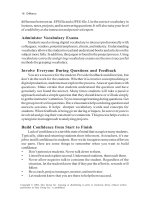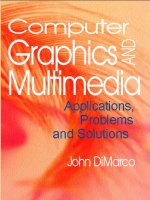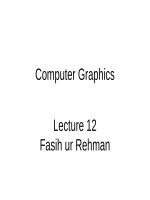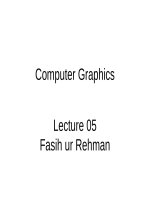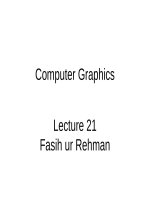Lecture Computer graphics: Lecture 25 - Fasih ur Rehman
Bạn đang xem bản rút gọn của tài liệu. Xem và tải ngay bản đầy đủ của tài liệu tại đây (316.73 KB, 17 trang )
Computer Graphics
Lecture 25
Fasih ur Rehman
Last Class
•
Shading
Today’s Agenda
•
Shading
What Shading can do?
•
Let us suppose we draw a circle
Phong Reflection Model
•
•
A simple model supports three models of
light – matter interactions
–
Diffuse
–
Specular
–
Ambient
and uses four vectors
–
normal
–
to source
–
to viewer
Ideal Reflector
Lambertian Surface
•
Perfectly diffuse reflector
•
Light scattered equally in all directions
•
Amount of light reflected is proportional to
the vertical component of incoming light
–
reflected light ~cos θi
–
cos θi = l ∙ n if vectors normalized
–
There are also three coefficients, kr, kb, kg
that show how much of each color component
is reflected
Specular Surfaces
•
•
Most surfaces are neither ideal diffusers
nor perfectly specular (ideal reflectors)
Specular highlights appear on smooth
surfaces due to incoming light being
reflected in directions close to the direction
of a perfect reflection
Specular Reflections Model
•
•
According to Phong, Reflected intensity Ir
goes as absorption coeff. ks and
projection of incoming intensity along
viewer (α is shinness coeff)
Ir ~ ks I cosαφ
The Shininess Coefficient
•
•
Values of α vary between 100 and 200 for
metals
Values vary between 5 and 10 for surfaces
that look like plastics
Ambient Light
•
•
•
Ambient light is the result of multiple
interactions between (large) light sources
and the objects in the environment
Amount and color depend on both the
color of the light(s) and the material
properties of the object
Add ka Ia (reflection coef * intensity of
ambient light) to diffuse and specular
terms
Distance Terms
•
•
•
The light from a point source that reaches
a surface is inversely proportional to the
square of the distance between them
We can add a factor of the form 1/(ad + bd
+cd2) to the diffuse and specular terms
The constant and linear terms
soften the effect of the point source
Light Sources
•
•
In the Phong Model, we add the results
from each light source
Each light source has separate diffuse,
specular, and ambient terms to allow for
maximum flexibility even though this form
does not have a physical justification
•
Separate red, green and blue components
•
Hence, 9 coefficients for each point source
–
Idr, Idg, Idb, Isr, Isg, Isb, Iar, Iag, Iab
Material Properties
•
Material properties match light source
properties
–
Nine absorbtion coefficients
•
–
kdr, kdg, kdb, ksr, ksg, ksb, kar, kag, kab
Shininess coefficient α
Summing up
•
For each light source and each color
component, the Phong model can be
written (without the distance terms) as
I =kd Id l ∙ n + ks Is (v ∙ r )α + ka Ia
•
For each color component
we add contributions from
all sources
Summary
•
Shading
•
Phong Reflection Model
References
•
•
Fundamentals of Computer Graphics Third
Edition by Peter Shirley and Steve
Marschner
Interactive Computer Graphics, A Topdown Approach with OpenGL (Sixth
Edition) by Edward Angel.



